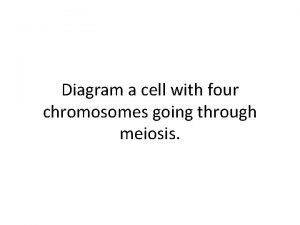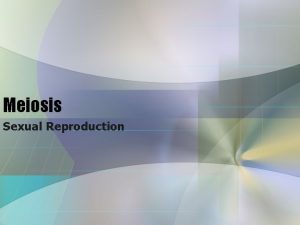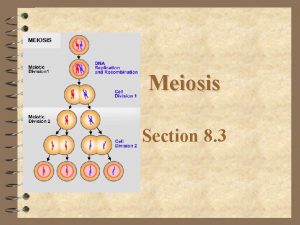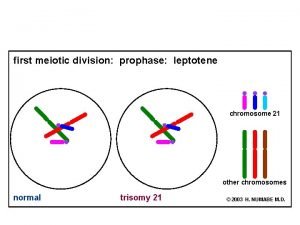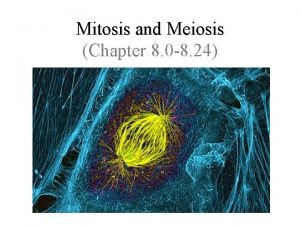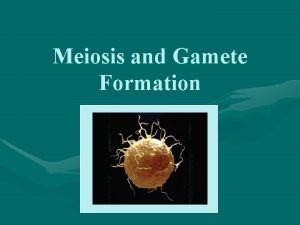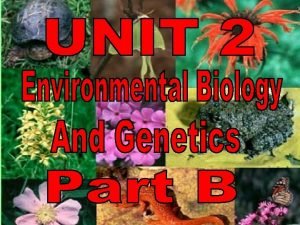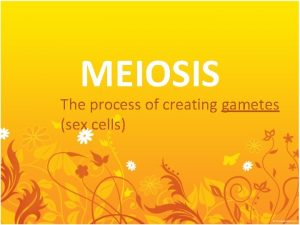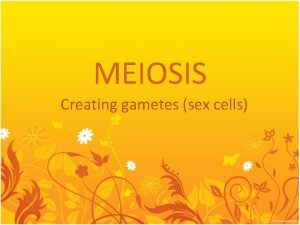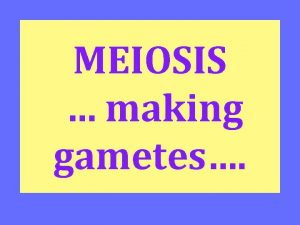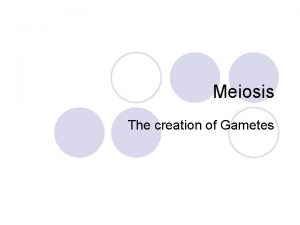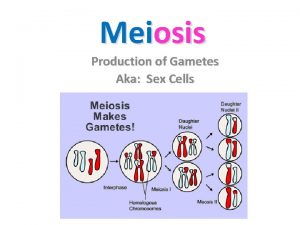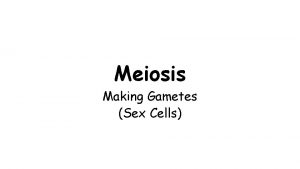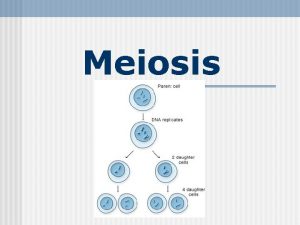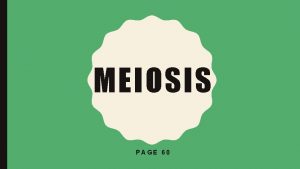MEIOSIS CREATING GAMETES SEX CELLS Page 97 EQ












- Slides: 12

MEIOSIS CREATING GAMETES (SEX CELLS) Page 97 EQ: Why is meiosis important for sexually reproducing organisms?

CHROMOSOMES

CHROMOSOMES • A human body cell (called a somatic cell) has 23 pairs of homologous chromosomes for a total of 46 chromosomes. • One chromosome of each homologous pair comes from the mother (called a maternal chromosome) and one comes from the father (paternal chromosome). • Homologous chromosomes are similar but not identical. • They carry the same genes in the same order, but the alleles for each trait may not be the same

DIPLOID AND HAPLOID • A cell that contains both sets of homologous chromosomes is said to be diploid • (2 sets; 2 N; 46 chromosomes) • Your somatic cells are diploid • A cell that only contains 1 set of chromosomes is said to be haploid. • (1 set; N; 23 chromosomes) • Your eggs/sperm cells are haploid

MITOSIS VS. MEIOSIS Mitosis • Results in 2 identical diploid cells • Involves asexual reproduction • 1 division • Function: growth & repair • • Meiosis Results in 4 genetically different haploid cells Involves sexual reproduction 2 divisions Function: create sex cells

MITOSIS VS. MEIOSIS

WHAT IS MEIOSIS? • Meiosis is a two-part cell division process occuring in organisms who sexually reproduce • The point of meiosis is to create gametes (egg & sperm cells) so that babies can be made • The random formation of gametes during meiosis creates genetic diversity in a population.

Chromosomes from parents Meiosis I Chromosomes from both parents are copied and paired so that crossing over can occur MEIOSIS 1 Chromosomes replicate Homologous chromosomes pair up Crossing over occurs Daughter nuclei have single chromosomes and a new mix of genetic material Nucleus divides into 2 nuclei Meiosis II Daughter nuclei divide again

PHASES OF MEIOSIS • Meiosis I: (P, M, A, T) 1 cell divides to create 2 diploid daughter cells • Meiosis II (P, M, A, T) 2 cells divide to create 4 haploid cells; this is when the gametes form

Meiosis I PHASES OF MEIOSIS • Your initial cell has 46 chromosomes – 23 from mom, and 23 from dad • These 46 chromosomes will duplicate into double stranded chromosomes – all 46 were initially single chromatids however they have replicated and become double stranded – There are still only 46 chromosomes! • In Meosis 1 the chromosomes will align in pairs – These are homologous pairs (ie code for same traits, one is from mom, the other from dad) – This is when crossing over occurs • The cell divides and you get two cells. Each cell now has 23 double stranded chromosomes. This is the end of Meiosis I

PHASES OF MEIOSIS Meiosis II • In both daughter cells, the chromosomes are aligned at the middle of the cell (NOT replicated) & then pulled apart A B

CROSSING OVER Occurs in Meiosis I 1. Homologous chromosomes form a tetrad 2. Chromatids cross over one another 3. The crossed sections of chromatids are exchanged ***This produces a new combination of genes which contributes to diversity within a population. ***
 Sex sex sex
Sex sex sex Sex sex sex
Sex sex sex Sex sex sex
Sex sex sex Secondary sexual characters
Secondary sexual characters Snv sex
Snv sex Diagram a cell with four chromosomes going through meiosis
Diagram a cell with four chromosomes going through meiosis Meiosis makes gametes
Meiosis makes gametes Section 8-3 meiosis
Section 8-3 meiosis Prophase
Prophase What is the purpose of mitosis?
What is the purpose of mitosis? How are mitosis and meiosis similar
How are mitosis and meiosis similar Sex determination and sex linkage
Sex determination and sex linkage Once a sex offender always a sex offender
Once a sex offender always a sex offender





